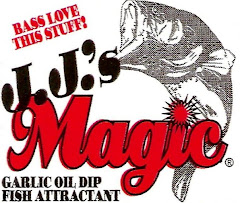This is the first of what I hope to be many posts that showcase and spotlight the companies and people who deserve some recognition. I am going to focus on the people in the bass fishing community who are just like the rest of us, the ones who you'd like to spend a day on the water with. First up is
Sasquatch Soft Plastics!
Soft plastics baits are no doubt the best selling and in my opinion, the best producing, bass lures on the market. Companies come and go and many seem to be exactly the same as the next one. All you need to do is pour some watermelon/red flake and green pumpkin worms and you're in business. That's not how Derek Kaalberg at Sasquatch does things. To him, it's more than just making baits that everyone else can do. He is about making unique and totally custom baits for each customer. Sure, he will pour you 10 inch worms in Junebug, but the idea behind his company is that "color choices are COMPLETELY custom, meaning you have the power to choose what you want. No exceptions!" I ordered some of his Spooky Flukes in a secret color earlier this year and they have been awesome.
I had the chance to talk with Derek recently and asked him a few questions about his company and how he got started.
TB: How did you start pouring soft plastic baits?
DK: Well, I used to make homemade spinnerbaits with my dad when I was younger, and I always loved it. We even played around with fly tying, but when I started tournament fishing in 2009, it didn't take long to figure out that these guys are looking for something that is a little different to get a leg up on the competition. So that Winter, I started looking for custom baits myself, and kept finding the same styles here and there from different custom plastic guys. The wheels started turning and I remembered how much I loved making my own tackle.
TB: How long does it take it from thought to design to finished product?
DK: It is surprisingly fast. After I got my first set of custom molds made into aluminum injection molds, I kinda sat back and thought, "Wow, a couple months ago, these were just ideas scribbled on paper!"
Step by step, what my brother and I did was ultimately draw the designs on paper. They were either compilations of different baits or just crazy ideas we had thought up.
Next, we use some craft-grade modeling clay and make a scale version of the bait. When we get it just right, we bake it in the oven to harden up the clay.
Now the work and waiting begins. In order to get a copy of our idea into a plastic bait, we needed a simple yet effective molding process. Simply put, Plaster of Paris. Theres a lot more to it than that, but hey, I can't share EVERYTHING.
After the plaster molds are refined and plastics are poured and tank tested and everything seems to work and look alright, I send the clay models off to a mold maker.
TB: What are your best sellers?
TB: What are the coolest custom colors you have made?
DK: In starting this, I have had requests for so many cool colors and seeing them written on paper does it no justice at all. It's awesome to see some of these colors come to life right in front of you and I must say, I do have some new favorites.
But the single most crazy color I have done was for Pro-Staffer Devon Gamboe who is on the Moline High School Tournament Bass Fishing Team. Devon asked for a custom 6" Littlefoot finesse worm. The body of the worm was watermelon/blue sapphire laminate with a blood red spade tail. It was a very cool looking bait and kind of reminded me of a clown pattern. Normally, I will not release a customer's custom color unless they don't mind.
The custom aspect of Sasquatch is the coolest thing for me. To be able to provide anglers with that favorite color that had been discontinued or a color they thought up on their own is awfully rewarding. Just the thought of anglers catching fish on baits I made is enough of a reward for me and I truly mean that!
TB: So what's next for Sasquatch?
DK: The sky is the limit. We are still drawing up new designs and trying to get the name out there. I think with the Pro-Staffers I have now, Sasquatch will be more recognized across the bass fishing community come next Summer. I myself will be fishing the B.A.S.S. Weekend Series events to help promote the brand. But as long as I love and enjoy making custom baits for myself and customers I don't really see Sasquatch Soft Plastics going anywhere but up. The baits work for me, it's just convincing everyone else that they will work for them!
It was great talking with Derek and his enthusiasm showed. He really cares about making great baits and making his customers happy. If you have an idea for a color and nobody is making it, give him a call: (309)738-1322. You will be impressed.
By: Tyler Brinks
















